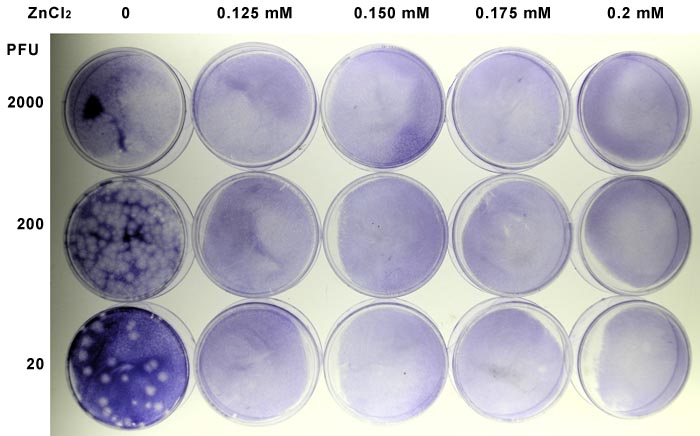My experiments to understand how ZnCl2 inhibits rhinovirus replication have been thwarted by the finding that concentrations of the salt higher than 0.1 mM are toxic for cultured HeLa cells. The cells can tolerate 0.1 mM but not 0.2 mM ZnCl2. Last week I asked whether I could identify a concentration between 0.1 and 0.2 mM that does not harm the cells but inhibits viral plaque formation >99%. Here are the results.


Unfortunately even 0.125 mM ZnCl2 is toxic to the cells – which is surprising since the cells can tolerate 0.1 mM. The goal of these experiments is to identify Zn-resistant rhinovirus mutants, and this cannot be done with cell monolayers that are not healthy.
I have one more idea for how to get around the ZnCl2 toxicity. To improve the formation of rhinovirus plaques, 25 mM MgCl2 is added to the agar overlay. It is possible that this high amount of magnesium, together with 0.2 mM ZnCl2 or higher, is toxic to cells. Therefore I will determine whether Zn toxicity is reduced if MgCl2 is omitted from the agar overlay. The rhinovirus plaques will be smaller but that is a reasonable trade-off for healthier monolayers.
If omitting MgCl2 doesn’t work, then I will have to select Zn resistant rhinovirus mutants in cells propagated in liquid cell culture medium. I’ll explain that approach next week.

Since these cells grow fine in 0.1mM ZnCl2, will this work: passaging these cells in 0.1mM ZnCl2 for certain period so that cells become adapted to 0.1mM salt concentration then increasing the salt concentration above 0.1mM?
Yes, I think that's a very good idea. I'm sure I could derive cells
resistant to higher concentrations of ZnCl2. I'll give it a try,
starting Monday!
Vincent – have you seen Chemico-Biological Interactions 69:279-291 (1989) (Cytotoxicity of zinc in vitro)? Perhaps increasing Ca might be worth a try, if you haven't already. From the abstract –
“The proliferation of B16, HeLa and I-221 cell lines was inhibited by 1.25 × 10−4, 1.50 × 10−4 and 1.50 × 10−4 mol/l Zn2+, respectively. The free radical scavengers, methimazole and ethanol, did not suppress the toxicity of Zn2+, neither did superoxide dismutase or catalase. The addition of the chelating agent EDTA reduced the zinc cytotoxicity. It was possible to suppress the cytotoxicity of zinc by increasing the concentration of either Fe2+ or Ca2+ but not Mg2+, which suggests that a prerequisite for the toxic action of zinc is entry into cells using channels that are shared with iron or calcium. This view was supported by experiments in which transferrin intensified the cytotoxic action of zinc in serum-free medium.”
Hadn't seen that paper. If Ca reduces cytotoxicity by blocking
channels shared by Zn then it might block the antiviral action of the
metal. But I'll give it a try anyway – easy enough to do. Thanks for
bringing it up.
Pingback: Rhinovirus and zinc part 5: Magnesium is not the culprit
Is it worth trying an agar overlay? You start with agar containing the Zn you want….add another plain agar overlay and then your Hela cells…which you can infect with virus.
Is it worth trying an agar overlay? You start with agar containing the Zn you want….add another plain agar overlay and then your Hela cells…which you can infect with virus.